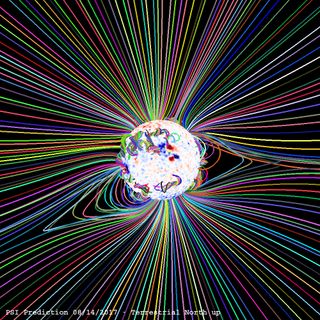Scientists Predicted What the Great American Eclipse Would Look Like, and Nailed It

Five days before the solar eclipse wowed skywatchers across the continental United States, the researchers at Predictive Science Inc. already knew what they'd see. The private computational physics research company had modeled the sun's upper atmosphere, called the corona, with data from NASA's Solar Dynamics Observatory (SDO). NASA compared the simulated results to the actual eclipse in a statement on Oct. 13.
Unlike eclipse chasers, SDO stares at the sun year-round, collecting data. One of its instruments, the Helioseismic and Magnetic Imager, measures electric currents and magnetic fields in the corona. Since the sun is made of hot, charged gas, called plasma, these electromagnetic phenomena play a central role in the dynamics of the sun. Filaments of plasma follow the sun's magnetic field lines, creating currents that generate new fields in turn. Sometimes plasma arcs high above the sun's surface in massive flares, showering the solar system with radiation.
Solar physicists at Predictive Science used the SDO data to model how the sun's currents and fields would shape its upper atmosphere. The complex simulations took nearly two days to complete, even with the help of powerful supercomputers. But the results are exceptionally accurate.

The corona is visible from Earth only during a total solar eclipse, when the moon blocks the blinding light emanating from below. The eclipse on Aug. 21, 2017, provided researchers at Predictive Science an opportunity to test their models' predictive power, but the team's goals are more far-reaching: As they develop more accurate models, they hope to expand our understanding of the dynamic processes at work in the sun. The group plans to continue developing its models in an effort to expand our understanding of the fundamental aspects of solar physics, according to the statement.
Eventually, the group hopes to transition its simulations into a system that can predict severe space weather, like massive solar flares, which poses a danger to modern infrastructure, NASA officials said in the statement. An early warning of just a few days could help avert billions of dollars in damages to telecom and power infrastructure, as well as the hundreds of millions of lives this would impact.
Email Harrison Tasoff at htasoff@space.com or follow him @harrisontasoff. Follow us @Spacedotcom, Facebook and Google+. Original article on Space.com.
Get the Space.com Newsletter
Breaking space news, the latest updates on rocket launches, skywatching events and more!
Join our Space Forums to keep talking space on the latest missions, night sky and more! And if you have a news tip, correction or comment, let us know at: community@space.com.

Harrison Tasoff is a science journalist originally from Los Angeles. He graduated from NYU’s Science, Health, and Environmental Reporting Program after earning his B.A. in mathematics at Swarthmore College. Harrison covers an array of subjects, but often finds himself drawn to physics, ecology, and earth science stories. In his spare time, he enjoys tidepooling, mineral collecting, and tending native plants.
